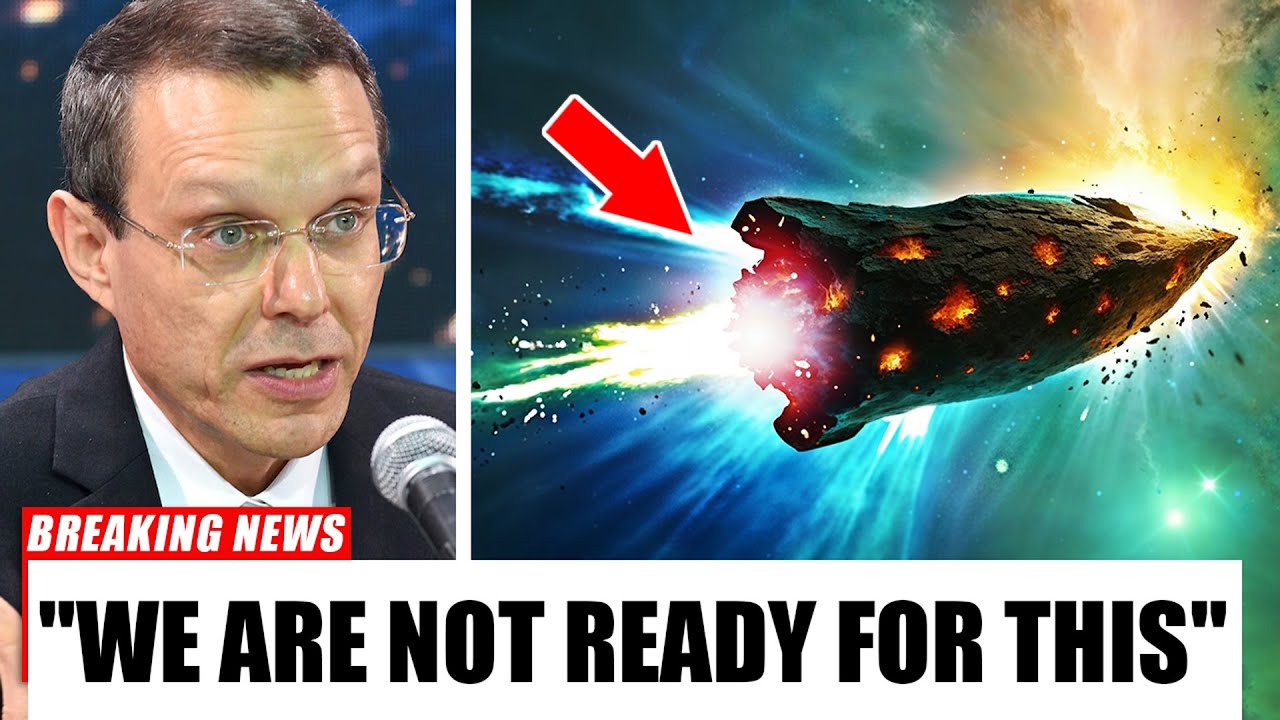🚨 NASA just let slip a cosmic shocker: The “tail” of interstellar comet 3I/ATLAS isn’t just dust—it looks eerily like a propulsion trail blazing through our solar system! 👽🚀
Strange glows, bizarre maneuvers, and a trajectory that defies nature’s playbook. Is this a comet or a spacecraft leaving clues in its wake? The truth could rewrite our place in the universe…
Curious what NASA’s hiding? Dive into the mystery now:

A viral storm has erupted online, with claims that NASA has “admitted” the tail of the interstellar comet 3I/ATLAS resembles a propulsion trail rather than the dust and gas expected from a typical comet. Fueled by sensational YouTube videos and social media posts, the narrative paints the object—discovered in July 2025—as a potential alien spacecraft, its glowing trail a sign of advanced technology. NASA, however, has firmly denied these assertions, stating that the tail’s appearance is entirely consistent with natural cometary behavior driven by solar heating. The controversy, blending real astronomical data with speculative leaps, highlights the challenge of separating fact from fiction as this rare interstellar visitor captivates the public.
A Cosmic Traveler’s Journey
The story began on July 1, 2025, when the NASA-funded Asteroid Terrestrial-impact Last Alert System (ATLAS) telescope in Chile spotted 3I/ATLAS, marking it as the third confirmed interstellar object to visit our solar system, after ‘Oumuamua in 2017 and 2I/Borisov in 2019. Racing at 130,000 miles per hour, the comet originates from the direction of the constellation Lyra and follows a hyperbolic path, meaning it’s not bound to our Sun and will exit the solar system after a brief tour. Its itinerary includes a close pass by Mars on October 3 at 28 million kilometers, its closest approach to the Sun (perihelion) on October 29-30 at 203 million kilometers, a Venus flyby in early November, and a distant rendezvous with Jupiter in March 2026. Earth’s closest encounter comes December 19 at 270 million kilometers—roughly four times the Earth-Moon distance—posing no threat, according to NASA’s Planetary Defense Coordination Office.
Early observations from the Hubble Space Telescope in July revealed a compact nucleus, estimated at 3.5 to 5.6 kilometers wide, surrounded by a reddish dust cloud but lacking a prominent tail. By late August, images from the Gemini South telescope and astrophotographers showed a growing blue-green coma and a lengthening tail, signs of ices vaporizing under solar heat. Advanced instruments, including the James Webb Space Telescope (JWST) and the European Southern Observatory’s Very Large Telescope (VLT), analyzed the tail’s composition, finding a high ratio of carbon dioxide to water ice (8:1), along with traces of cyanide, nickel, and organic molecules called tholins. These complex carbon compounds, formed by cosmic radiation, suggest 3I/ATLAS hails from a distant star system, possibly 7 billion years old. The green hue, typically linked to dicarbon (C2) in local comets, puzzled scientists due to low C2 levels but is now attributed to solar fluorescence of organic materials—a natural process.
The Propulsion Rumor
The claim that 3I/ATLAS’s tail resembles propulsion stems from misinterpretations of scientific discussions, particularly those from Harvard astrophysicist Avi Loeb. In an August blog post, Loeb noted the comet’s early brightness—equivalent to gigawatts of power—seemed too intense for mere dust reflection or outgassing, speculating it could indicate a compact energy source, like nuclear propulsion. He highlighted the object’s unusual trajectory, which aligns closely with the solar system’s planetary plane and allows flybys of Venus, Mars, and Jupiter, a statistical rarity with 1-in-20,000 odds. Loeb suggested a 40% chance of artificial origins, calling for further study, but stressed this was a hypothesis, not a conclusion, and leaned toward a natural explanation.
Online content creators ran with this, distorting it into a NASA “admission.” A September 20 YouTube video from Cosmic Insider, titled “NASA Admits: 3I/ATLAS Tail Looks Like Alien Propulsion, Not Dust!”, claimed agency insiders confirmed a “jet-like” trail, garnering 150,000 views in days. Another video from Starry Skies on September 18 alleged a “leaked NASA report” showed engine-like emissions, offering no credible evidence. On X, users like @SpaceTruthX posted on September 19 that NASA’s Jet Propulsion Laboratory found “non-gravitational thrust,” a claim echoed by @CosmicPulse22, who shared altered Hubble images suggesting the tail’s structure mimics sci-fi ion drives. These posts, amassing thousands of shares, fueled a narrative of a cosmic cover-up.
NASA swiftly countered. A September 21 statement clarified: “The tail of 3I/ATLAS results from solar-driven outgassing of ices like CO2 and water. There’s no evidence of propulsion or artificial origins.” JWST and VLT data confirm the tail contains dust grains (0.1 to 10 micrometers) and gases, with no signs of metallic or ionized exhaust. The green glow, initially confusing, aligns with natural fluorescence, not technology. NASA’s SPHEREx mission, which studied the comet’s ices in August, found no anomalies suggesting artificial activity.
Social Media’s Role
The propulsion rumor thrives on social media’s ability to blend fact and fiction. On X, @UAPWatchdog claimed on September 22 that NASA suppressed “propulsion data” to avoid public panic, citing unnamed JPL sources. @AlienTruthSeeker posted manipulated VLT images on September 20, emphasizing the tail’s “linear” form as proof of engines, ignoring dust dynamics. Conspiracy accounts like @ZeroHedgeX linked the comet to sci-fi “Dark Forest” theories, suggesting it’s a cloaked alien probe. A September 10 Joe Rogan podcast clip with physicist John Brandenburg misread the tail’s brightness as “smelting emissions,” adding fuel to the fire.
Countering the hype, X users like @AstroDebunker shared VLT spectra on September 21, noting that dust scattering fully explains the tail’s appearance. Former NASA contractor Marian Rudnyk tweeted on September 19 that the claims recycle old ‘Oumuamua speculation, emphasizing 3I/ATLAS’s cometary traits. Community notes on X have flagged misleading posts, linking to NASA’s Minor Planet Center data showing a stable orbit with no unexplained motion.
Ongoing Observations
NASA and global observatories are studying 3I/ATLAS not for alien signals but for its scientific value. The European Space Agency’s Mars Express and ExoMars Trace Gas Orbiter will image the comet’s October 3 Mars flyby, analyzing gas emissions to probe its origins. NASA’s Juno mission, nearing Jupiter, may capture tail particles in March 2026, while the Swift telescope’s gamma-ray scans have ruled out artificial energy sources. TheSkyLive’s real-time tracker, updated September 24, places the comet in Libra, following its predicted path. Pre-discovery images from the Transiting Exoplanet Survey Satellite (TESS) in May 2025 show consistent cometary activity, not maneuvers.
Jacqueline McCleary, an astronomer at Northeastern University, told Space.com on September 15 that the tail’s growth and green hue are “textbook cometary responses to solar heating.” BBC Sky at Night’s September 20 issue dismissed propulsion claims as “baseless,” noting the tail’s dust particle sizes match known comets. The Independent reported on September 17 that the tail’s CO2-driven expansion is a “cosmic spectacle,” not a thruster.
A Familiar Frenzy
The propulsion narrative mirrors past extraterrestrial scares, like ‘Oumuamua’s light-sail buzz in 2018 or Hale-Bopp’s 1997 cult hysteria. IFLScience’s September 16 fact-check traced the claims to a misquoted Loeb blog, urging readers to verify primary sources. The Guardian’s September 19 article, “Comet Hype vs. Reality,” highlighted 3I/ATLAS’s CO2 richness as a clue to distant planetary systems, not alien tech. With the Vera C. Rubin Observatory set to detect thousands of interstellar objects yearly from 2026, such debates may become commonplace.
Loeb’s Galileo Project continues advocating for technosignature searches, proposing SpaceX Starship missions to intercept objects like 3I/ATLAS, but no such plans are underway. On X, posts like @StarGazerX’s September 23 claim of “NASA hiding propulsion proof” persist, countered by @ScienceFactCheck’s data-driven rebuttals. As 3I/ATLAS nears perihelion, its tail may flare dramatically by December, potentially visible with binoculars—a natural wonder, not a machine.
NASA’s Thomas Statler told The Debrief on September 22: “This is a comet, not a spacecraft. It’s a chance to learn, not to sensationalize.” In an era of viral misinformation, 3I/ATLAS reminds us that the cosmos holds mysteries best unraveled through science, not speculation. As telescopes track its arc, the real story lies in its ancient journey, not in fabricated tales of propulsion.





